I'll be moderating FireDogLake's Book Salon today with Amanda Little, author of Power Trip. Hope you can join us!
Saturday, July 30, 2011
Today at 5pm: Join the FDL Book Salon with Amanda Little
Posted by
TheGreenMiles
at
Saturday, July 30, 2011
Friday, July 29, 2011
Shocking News: I Agree With Richmond Times-Dispatch On BRAC
 Huge traffic changes are coming to Alexandria thanks to the Defense Department's Base Realignment & Closure Commission (BRAC), but little has been done to figure out how 6,400 federal employees will get to & from Alexandria’s Mark Center.
Huge traffic changes are coming to Alexandria thanks to the Defense Department's Base Realignment & Closure Commission (BRAC), but little has been done to figure out how 6,400 federal employees will get to & from Alexandria’s Mark Center.The conservative Richmond Times-Dispatch editorial board rightly heaps a share of the BRAC blame on the slouched shoulders of Gov. Bob McDonnnell (R-VA) and his fellow Republicans who control a majority of Virginia's state government:
Virginia has known for years that base consolidation would bring more workers here. But it has failed to get ready, because state leaders — almost exclusively Republicans — have failed to take the necessary step: raising the gasoline tax, whose value has been greatly eroded by inflation.Metro is adding a bus line, but that project is being supported by the Defense Department & City of Alexandria, not the state. And considering Gov. McDonnell waffled as his Congressional Republican friends like Rep. Eric Cantor (R-VA) tried to slash Metro's budget, McDonnell may actually be doing less than nothing.
To be sure: Contrary to the impression given by certain Democrats, raising the gasoline tax is not the only step the state should take to address road woes. Land-use planning needs an overhaul (Gov. Tim Kaine started work on that). Zoning rules need relaxing, and telecommuting, flextime and similar measures need encouraging.
Posted by
TheGreenMiles
at
Friday, July 29, 2011
New Report Sheds Light on Arlington Skunk Scarcity
 A few years back, the Washington Post asked why skunks flunk Arlington. The County's new natural heritage resource report (PDF) takes an in-depth look at a long list of species & their relationships with Arlington, concluding Arlington just isn't good skunk habitat:
A few years back, the Washington Post asked why skunks flunk Arlington. The County's new natural heritage resource report (PDF) takes an in-depth look at a long list of species & their relationships with Arlington, concluding Arlington just isn't good skunk habitat:Striped Skunk Mephitis mephitis nigra. The striped skunk is well known, but rarely encountered in Arlington. Historical records include a single early record from 1878 (Four Mile Run) and a later record in 1946 from N. Nelson St. The absence of skunks from the local environment is not unexpected. Based on dietary need, skunks primarily inhabit open fields, old field meadows, thick brush land, pastures and farmland. Past environmental changes in Arlington have eliminated natural meadows and farmland and replaced them largely with an urban landscape or mature forest. Over the course of the wildlife inventory, a number of citizen reports were received claiming to have smelled an odor of skunk. A number of these reports were later dismissed as unverifiable or mistaken as male red fox scent. However, two reported observations within the period of 2003-2006 were followed up by interviews. In both cases, the reports were deemed credible. No contemporary documentation exists in the form of photos, bones, fur or scat. In addition, no road kills have been reported within the last ten years by two different reporting agencies. Arlington National Cemetery may provide the best remaining habitat for skunks in Arlington. Striped skunks remain more common in the less developed portions of Fairfax and Prince William Counties. Current Status: Rare, does not occur every year.One other interesting note from the report - get ready for more deer in South Arlington.
Posted by
TheGreenMiles
at
Friday, July 29, 2011
Thursday, July 28, 2011
Arlington Passes Strip Mall Preservation Act
Rest easy, strip malls of Arlington. The Arlington County Board has acted to let developers know if they try to turn you into housing, they can expect ... well, probably just a sternly-worded letter, but still:
From Fort C.F. Smith to the Key Bridge, I understand the value of preserving truly historic places & sites. But in a place like Arlington that's nearly 100% built-out, historic preservation doesn't exist in a vacuum. It's a choice between maintaining existing structures and the best available use of that land in redevelopment - often the choice between a short, single-purpose building that can serve a smaller number of people and a tall, multi-purpose building that can serve a much larger number of people.
This comment to my original post is the essence of why the sustainable development advocates at the Urban Land Institute thought my original post was from The Onion. The comment discusses the Colonial Village Shopping Center strip mall as if it was the Pyramide du Louvre & bashes "misguided," "pious transit-related development. It also ignores the inherent choice - that every time we give a one-story strip mall & parking lot the cover of preservation, we're choosing to block something else potentially more beneficial.
And let's face it: Arlington was a quiet bedroom community before transit-related development revitalized it. Actually, I don't even know if "revitalized" is the even right word, which implies we were this vital at some point in the past - Arlington is more lively in 2011 than it's ever been, and the graph is trending straight up.
Here's the most annoying contradiction: Does anyone fighting new multi-family housing near Metro want to give up the added value of their homes, wildly inflated by their proximity to these vibrant neighborhoods? Of course not.
He replied simply, "10,005."
County Board members on July 9 unanimously adopted an initial “historic resources inventory list,” which ranks nearly 400 properties constructed between 1909 and 1962 based on how important staff and a consultant believe it is to shield them from demolition. It is an effort, County Board Chairman Chris Zimmerman said, to make up for lost time.
“We didn’t have a great tradition of preservation in Arlington,” he said, particularly since the county has a limited number of properties more than a century old.Never let a lack of actual historic properties stop you from declaring that whatever properties you have handy are historic.
The first phase of the effort focused on only a very narrow slice of property types in Arlington: garden apartments, shopping centers and commercial properties more than 50 years old. Leventhal said those types of properties are most vulnerable to redevelopment.As the National Trust for Historic Preservation points out, in many cases the greenest building is the one that's already built. But saying properties more than 50 years old are most vulnerable to redevelopment is like saying cars more than 10 years old are most vulnerable to being traded in. Even if it's still functional, does it still meet your needs? Will it be a slight to the historic value of TheGreenMilesMobile if I need a roomier car when I have kids?
From Fort C.F. Smith to the Key Bridge, I understand the value of preserving truly historic places & sites. But in a place like Arlington that's nearly 100% built-out, historic preservation doesn't exist in a vacuum. It's a choice between maintaining existing structures and the best available use of that land in redevelopment - often the choice between a short, single-purpose building that can serve a smaller number of people and a tall, multi-purpose building that can serve a much larger number of people.
This comment to my original post is the essence of why the sustainable development advocates at the Urban Land Institute thought my original post was from The Onion. The comment discusses the Colonial Village Shopping Center strip mall as if it was the Pyramide du Louvre & bashes "misguided," "pious transit-related development. It also ignores the inherent choice - that every time we give a one-story strip mall & parking lot the cover of preservation, we're choosing to block something else potentially more beneficial.
And let's face it: Arlington was a quiet bedroom community before transit-related development revitalized it. Actually, I don't even know if "revitalized" is the even right word, which implies we were this vital at some point in the past - Arlington is more lively in 2011 than it's ever been, and the graph is trending straight up.
Here's the most annoying contradiction: Does anyone fighting new multi-family housing near Metro want to give up the added value of their homes, wildly inflated by their proximity to these vibrant neighborhoods? Of course not.
So what's next?
Still down the road is a similar effort for the roughly 10,000 residential properties the county government believes have historic value.Arlington has 207,627 residents with about 90,000 households & around 60% of residents live in multi-family units. I emailed a friend who works in local real estate, "Arlington County thinks there are '10,000 residential properties' with 'historic value'? Come on. How many houses are there in Arlington total?"
He replied simply, "10,005."
Posted by
TheGreenMiles
at
Thursday, July 28, 2011
Wednesday, July 27, 2011
Key Smokefree Advocate Making Political Comeback?
 I hadn't heard smokefree advocate Brandon Bell's name since he was primaried out of office as part of a Republican purge of moderates in 2007. But today, Ben Tribbett reports he could be mounting a political comeback, considering a run for Virginia State Senate an independent.
I hadn't heard smokefree advocate Brandon Bell's name since he was primaried out of office as part of a Republican purge of moderates in 2007. But today, Ben Tribbett reports he could be mounting a political comeback, considering a run for Virginia State Senate an independent.Given the popularity of Virginia's smoking ban in bars & restaurants (59% of Americans now want smoking banned in all public places), the support for clean air & public health that made him so unpopular in today's extremist Republican Party could make him a rock-solid centrist choice.
Posted by
TheGreenMiles
at
Wednesday, July 27, 2011
Drivers Oppose The Best Policy To Speed Their Commutes
 Studies have shown that while people like to complain about traffic, most long-haul commuters don't do anything to change their drives. Today's Washington Post article is misleadingly headlined
Studies have shown that while people like to complain about traffic, most long-haul commuters don't do anything to change their drives. Today's Washington Post article is misleadingly headlinedTraffic science struggles to keep cars flowing on highways in D.C. and elsewhere - we know exactly how to keep traffic flowing, but drivers would rather pay less to sit in gridlock:
First, we don’t hate spending time in our cars as much as we pretend to. How do I know? “Because building more roads doesn’t improve traffic flow,” says Chris Barrett, a Virginia Tech professor who constructs traffic modeling systems and was involved in the Los Alamos effort. “If you decrease the amount of time it takes to travel a certain distance to work, people just move farther away from their offices [for larger yards and cheaper housing, instead of staying put to reduce their commutes]. It changes behavior in a negative way.”That's not a failure of science. That's a failure of political will.
Moreover, people have strongly resisted the best congestion-fighting tool that can be immediately implemented. Every traffic expert I spoke with pointed out the runaway success of London’s congestion pricing system. Drivers who want to enter the heart of the city during busy times have to pay 10 pounds — about $16. The system has made a huge difference in reducing congestion, and the city is using the extra revenue to renovate the subway and add buses.
New York Mayor Michael Bloomberg tried to adopt a similar strategy in 2007, but the state government killed it. A congestion tax has never gotten anywhere in the D.C. area, which one recent survey found was first in the nation as measured by hours wasted stuck in traffic.
So instead of gridlock-busting congestion pricing that could be used to fix Metro, we get Gov. Bob McDonnell (R-VA) trying to make it look like he's doing something by pushing terrible ideas like the Outer Beltway and Charlottesville Bypass that will cost taxpayers enormous sums of money without easing traffic.
Posted by
TheGreenMiles
at
Wednesday, July 27, 2011
Tuesday, July 26, 2011
What If Your Family Tightened Its Belt GOP-Style?
Claiming that cutting millions from public health & wildlife protections is about "belt-tightening" while ignoring the multi-trillion dollar Bush tax cuts is like telling your kids you're cutting their allowance but keeping the Porsche.
I'm glad the House Sustainable Energy & Environment Coalition is taking a stand.
Posted by
TheGreenMiles
at
Tuesday, July 26, 2011
Monday, July 25, 2011
The Green Miles, Now Available In Tie Form
Unfortunately, The (green/grey) Miles is currently listed as sold out at TheKnottery.com.
Posted by
TheGreenMiles
at
Monday, July 25, 2011
I For One Welcome Our New Bunny Overlords
If you follow me on Twitter or FourSquare, you know I've been amazed at how many rabbits have been hanging out in East Falls Church this year. It's rare that I can walk down Sycamore Street to EFC Metro without spotting at least one, if not 3 or 4.
ArlNow.com reports it's part of a regional bunny boom:
ArlNow.com reports it's part of a regional bunny boom:
“It is indeed a boom year for rabbits in the county,” [Arlington County Parks spokesman Nathan] Spillman said, “Rabbit populations here are cyclical and about every seven or eight years you see a large spike in the population followed by a relatively steep (and quick) decrease as the boom attracts predators like foxes and hawks which bring the population down… It’s likely the decline will start to become noticeable as early as this November.”
According to a just-released inventory of wildlife in Arlington (PDF), the rabbit population in Arlington (made up mostly of Eastern Cottontails, pictured) typically moves in cycles with the population of its primary predator, the fox.And they're quite accustomed to people. The photo above was the second one I took - the first one I accidentally had the flash on. The bunny in the foreground didn't run away at the flash, just perked up its ears for a minute, then went back to munching clover.
Posted by
TheGreenMiles
at
Monday, July 25, 2011
Saturday, July 23, 2011
I Think I May Be A Corn Farmer
These started growing on the edge of my patio a couple of weeks ago and are now waist high. Are they corn?
Posted by
TheGreenMiles
at
Saturday, July 23, 2011
Friday, July 22, 2011
Why Don't Feds Have Telework Option on Extremely Hot Days?
Federal government workers in the DC area are allowed to telework when it snows. Why aren't they encouraged to do so on extreme heat days?
I asked Federal News Radio's Amy Morris about the federal government's heat wave telework policy. She looked into it and tweeted that there's no broad policy, only that, "The office manager has discretion depending on office conditions, etc."
If federal government workers were allowed to telework in the most extreme heat (say, on days when the heat index is forecast to be over 105), there would be several real benefits:
Of course, our climate is now even hotter than it was in DC's early days, and it's getting worse fast. Globally, June was 1.60 degrees F hotter than the 20th century average. And considering Congress hasn't curbed America's carbon emissions and the world has copied our inaction, we're hurtling towards the most extreme changes.
Letting feds telework on the hottest of hot days won't protect DC from global warming, but it would be an easy step to making it a bit more tolerable.
UPDATE: Federal News Radio posts this memo on the heat from the Office of Personnel Management to agency heads, which advises managers to keep employees hydrated but says nothing about teleworking.
I asked Federal News Radio's Amy Morris about the federal government's heat wave telework policy. She looked into it and tweeted that there's no broad policy, only that, "The office manager has discretion depending on office conditions, etc."
If federal government workers were allowed to telework in the most extreme heat (say, on days when the heat index is forecast to be over 105), there would be several real benefits:
- Air quality. The Metropolitan Washington Council of Governments is forecasting unhealthy air for the next few days thanks to a combination of heat and ozone pollution. With about 103,000 federal workers telecommuting in 2008, that's potentially a large number of tailpipes off the road.
- Easing transportation strain. On extreme heat days, cars break down more often and Metro cars without air conditioning become unbearable hot cars.
- More productive workers. If you have to start your day drenched in sweat, you're not going to be at your most productive - you're going to be watching the clock until you can go home and drink a gin & tonic the size of your head. Teleworkers, on the other hand, are scientifically proven to be more productive than their commuting counterparts.
Of course, our climate is now even hotter than it was in DC's early days, and it's getting worse fast. Globally, June was 1.60 degrees F hotter than the 20th century average. And considering Congress hasn't curbed America's carbon emissions and the world has copied our inaction, we're hurtling towards the most extreme changes.
Letting feds telework on the hottest of hot days won't protect DC from global warming, but it would be an easy step to making it a bit more tolerable.
UPDATE: Federal News Radio posts this memo on the heat from the Office of Personnel Management to agency heads, which advises managers to keep employees hydrated but says nothing about teleworking.
Posted by
TheGreenMiles
at
Friday, July 22, 2011
Thursday, July 21, 2011
Dirty Distinction: Virginia 14th on Power Plant Pollution List
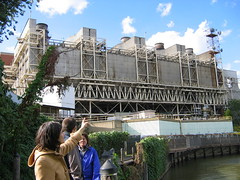 Virginia comes in 14th-worst on a new ranking of states with the most toxic air pollution from coal- and oil-fired power plants, according to an analysis by the Natural Resources Defense Council, released jointly with Physicians for Social Responsibility (PSR). Ohio, Pennsylvania and Florida have the highest levels of toxic power plant pollution.
Virginia comes in 14th-worst on a new ranking of states with the most toxic air pollution from coal- and oil-fired power plants, according to an analysis by the Natural Resources Defense Council, released jointly with Physicians for Social Responsibility (PSR). Ohio, Pennsylvania and Florida have the highest levels of toxic power plant pollution.The Environmental Protection Agency is planning new rules to limit the toxic pollutants such as mercury, but those limits are coming under attack from friends of coal & oil in Congress:
The EPA estimates that the reductions of toxic pollution required by the pending “Mercury and Air Toxics” standard would save as many as 17,000 lives every year by 2015 and prevent up to 120,000 cases of childhood asthma symptoms. The safeguards also would avoid more than 12,000 emergency room and hospital visits and prevent 850,000 lost work days every year. These standards are expected to be finalized in November; the agency is taking public comments on its proposal until Aug. 4, 2011.Tell your members of Congress & the EPA to back strong mercury pollution standards.
“Coal pollution is killing Americans,” said Lynn Ringenberg, MD, of Physicians for Social Responsibility. “It is America’s biggest source of toxic air pollution. Air toxics from coal-fired power plants cause cancer, birth defects, and respiratory illness. Just one of those air toxics, mercury, damages the developing brains of fetuses, infants, and small children. It robs our children of healthy neurological development and native intelligence.
“Poisonous power threatens the health of our kids and families. As a pediatrician for over thirty years, I urge us absolutely to support the EPA’s efforts to reduce the health threat from coal.”
Posted by
TheGreenMiles
at
Thursday, July 21, 2011
Heat Wave Humor: This Soup Tastes Salty
Spotted this morning in front of Zola Wine Kitchen on E St NW at 9th:
I'll be heading there for lunch - soup may be a bit heavy today, but the southwestern chicken salad wrap sounds great on a steamy Anthropocene afternoon.
I'll be heading there for lunch - soup may be a bit heavy today, but the southwestern chicken salad wrap sounds great on a steamy Anthropocene afternoon.
Posted by
TheGreenMiles
at
Thursday, July 21, 2011
Wednesday, July 20, 2011
Why Isn't Fox Talking About Global Warming This Week?
Posted by
TheGreenMiles
at
Wednesday, July 20, 2011
Tuesday, July 19, 2011
Breaking News: Heat Index of 116 Forecast for Friday
Did I just use the term "breaking news" to describe a weather forecast for a sunny day? Yup. That just happened.
Last month, I asked If June Is This Hot, What Will July & August Be Like? Now we have the answer from Jason Samenow of WashingtonPost.com's Capital Weather Gang:
Image courtesy NOAA’s Hydrometeorological Prediction Center via Capital Weather Gang
Last month, I asked If June Is This Hot, What Will July & August Be Like? Now we have the answer from Jason Samenow of WashingtonPost.com's Capital Weather Gang:
NOAA has upped its peak heat index prediction for D.C. Friday to a stunning, sweltering 116 degrees. Remarkably, it predicts there is a 90 percent chance it will reach at least 110 and a 100 percent chance of at least 105. Earlier today, NOAA was predicting a maximum heat index of 109 Friday.So far, 2011 has been the 11th-warmest year on record. And from NOAA's State of the Climate update, a stat even The Green Miles didn't know:
And poor Richmond, Va.! NOAA projects its heat index will soar to a stifling 118 degrees.
June 2011 was the 316th consecutive month with a global temperature above the 20th century average. The last month with below-average temperature was February 1985.That's right - despite all of George Will's "global cooling" hot air, we haven't had a below-average global temperature month since before The Goonies came out. Excuse me while I cool myself off by doing the truffle shuffle:
Image courtesy NOAA’s Hydrometeorological Prediction Center via Capital Weather Gang
Posted by
TheGreenMiles
at
Tuesday, July 19, 2011
Monday, July 18, 2011
What's Worse Than a Coal-Fired Power Plant?
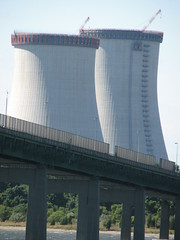 How about a coal-fired power plant with two 497-foot cooling towers?
How about a coal-fired power plant with two 497-foot cooling towers?The Green Miles spent the weekend with family in southeast Massachusetts, and the new towers at the Dominion-owned Brayton Point plant in Somerset were never far from view. (Here's how they look from four miles away in neighboring Swansea.)
How out-of-character for the region are they? If they were office buildings, they'd be the tallest in New England outside of Boston & Hartford. But it's distant offshore windmills that would be eyesores?
I took this video after a swim off the public docks across Mount Hope Bay in Bristol, Rhode Island. Even five miles away through the Flipcam's tiny lens, the two towers loom. They're supposed to cool the power plant's water discharge, which is the preferred solution if your prerogative is to keep the coal-fired power plant burning. But for the region's residents, is this really how they want to get their energy?
Posted by
TheGreenMiles
at
Monday, July 18, 2011
Saturday, July 16, 2011
The Potomac Overlook Regional Park Rap
While researching my post on recent storm damage at Potomac Overlook Regional Park, I found The Potomac Overlook Regional Park Rap:
Posted by
TheGreenMiles
at
Saturday, July 16, 2011
Thursday, July 14, 2011
Media Blaming Anything But Climate Crisis For Summer Extreme Weather
Climate scientists tell us global warming caused by man-made carbon pollution is fueling more heat waves and wildfires, along with precipitation extremes like drought and flooding.
As ClimateProgress.org reports, America's media has been trying to blame this summer's extreme weather on lots of things - none of them the climate crisis.
But if reporters tell the truth, they'll get angry emails from the Tea Party! What do you want them to do, tell the truth anyway? They're not Superman, people.
As ClimateProgress.org reports, America's media has been trying to blame this summer's extreme weather on lots of things - none of them the climate crisis.
But if reporters tell the truth, they'll get angry emails from the Tea Party! What do you want them to do, tell the truth anyway? They're not Superman, people.
Posted by
TheGreenMiles
at
Thursday, July 14, 2011
Monday, July 11, 2011
Potomac Overlook Regional Park Hit Hard by Recent Storms
Northern Virginia's been hammered by some strong thunderstorms in recent weeks, and our parks have been no exception. Potomac Overlook Regional Park has been hit particularly hard, with trees & branches littering the area around the nature center.
How bad is it? Martin Ogle, chief naturalist for the Northern Virginia Regional Park Authority, tells me Potomac Overlook Regional Park suffered "probably as much or more damage than during Hurricane Isabel in 2003." The park's website says its phone service has been knocked out.
Down the trail at Donaldson Run, the already-eroded banks show further signs of damage. When large amounts of rain fall quickly in a community that has ever-increasing amounts of impermeable surfaces, the stream gets more water than it can handle, piling the pressure on its basin.
It's not just soil & vegetation that can be stripped down. About 200 yards up from the Potomac River, what had once been a steep, rocky waterfall appears to have been broken up by flooding into more of a series of steps:
How bad is it? Martin Ogle, chief naturalist for the Northern Virginia Regional Park Authority, tells me Potomac Overlook Regional Park suffered "probably as much or more damage than during Hurricane Isabel in 2003." The park's website says its phone service has been knocked out.
Down the trail at Donaldson Run, the already-eroded banks show further signs of damage. When large amounts of rain fall quickly in a community that has ever-increasing amounts of impermeable surfaces, the stream gets more water than it can handle, piling the pressure on its basin.
It's not just soil & vegetation that can be stripped down. About 200 yards up from the Potomac River, what had once been a steep, rocky waterfall appears to have been broken up by flooding into more of a series of steps:
Posted by
TheGreenMiles
at
Monday, July 11, 2011
Will Murdoch Scandals Spark Interest in Finding Climate Email Hackers?
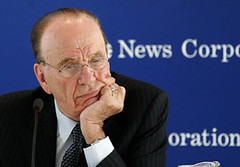 I know of no evidence Rupert Murdoch's news organizations had anything to do with the illegal hacks targeting email accounts of climate scientists. But given the widening scandal around the apparent willingness of Murdoch's News of the World to use hacking as a common newsgathering tool, shouldn't someone at least be looking into it?
I know of no evidence Rupert Murdoch's news organizations had anything to do with the illegal hacks targeting email accounts of climate scientists. But given the widening scandal around the apparent willingness of Murdoch's News of the World to use hacking as a common newsgathering tool, shouldn't someone at least be looking into it?The hackers targeted scientists not in America, but at Britain's University of East Anglia Climate Research Unit. Then a BBC weatherman was the first to receive hacked emails.
Will any reporter reopen the case? So far, the answer is no. A Google News search on the topic returns zero news articles. Only Treehugger has even raised the question.
The media - British and American alike - rushed to report to the controversy on the emails when actual investigations showed no scientific wrongdoing. But those same outlets have never shown any interest in identifying the criminals who perpetrated the hacking. (To be clear, I'm not accusing reporters of complicity - I'm accusing them of laziness.)
Posted by
TheGreenMiles
at
Monday, July 11, 2011
Thursday, July 7, 2011
Will Qatar Have To Change Soccer Rules to Accommodate World Cup in Desert?
 Can the 2022 Qatar World Cup hold outdoor soccer matches in one of the world's hottest places and keep its green promises? Questions have already been raised about designs for carbon-neutral stadiums. Now Qatar is having to deny reports the stadiums may get too hot to support 45-minute halves of soccer:
Can the 2022 Qatar World Cup hold outdoor soccer matches in one of the world's hottest places and keep its green promises? Questions have already been raised about designs for carbon-neutral stadiums. Now Qatar is having to deny reports the stadiums may get too hot to support 45-minute halves of soccer:Engineer Michael Beavon said at a conference in London on Wednesday that FIFA had a "forward-thinking" backup plan to divide matches into thirds, giving players more time to rehydrate if stadium temperatures rose above 84 degrees.As Barry Petchesky writes at Deadspin, "With all the Ts crossed, the Is dotted, and the money counted, FIFA is seemingly only now realizing that it gets really fucking hot in Qatar." And considering the Earth is warming at about 0.3 degrees F per decade, it'll be even hotter by the time 2022 rolls around.
Qatari officials responded that the claims by Beavon, a director of Arup Associates, were "without any foundation."
Posted by
TheGreenMiles
at
Thursday, July 07, 2011
Underrated Coal Voice on Capitol Hill: Rail Lobby
As detailed in The Last Mountain, coal shipments account for half of all heavy haul rail loads. TPM details how the rail lobby has spent more than $152 million on lobbying since 2007.
Posted by
TheGreenMiles
at
Thursday, July 07, 2011
Wednesday, July 6, 2011
DC To Fleece Car Sharers, Continue Heavily Subsidizing Car Owners
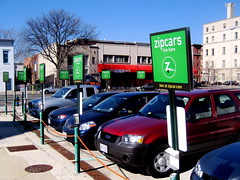 As Clayton Lane reports at TheCityFix.com, DC has decided to auction car sharing spaces in an effort to maximize revenue from car sharing companies. Which would be fine, if it was also auctioning the rest of the spaces. Imagine how much a street spot in Adams Morgan would go for?
As Clayton Lane reports at TheCityFix.com, DC has decided to auction car sharing spaces in an effort to maximize revenue from car sharing companies. Which would be fine, if it was also auctioning the rest of the spaces. Imagine how much a street spot in Adams Morgan would go for?But DC will continue to practically give away residential parking tags (first tag $15; second tag literally free), with the net result being a major subsidy for more privately-owned cars clogging the streets of DC:
Carsharing should be treated as a public good, even more than the on-street parking that it occupies. Each shared vehicle replaces about 14 private cars, according to comprehensive national research by the University of California, Berkeley. Plus, after joining, members drive about 44 percent fewer miles, according to the average result of ten North American impact studies. Other research shows that carsharing members consume less gas, reduce their carbon emissions by nearly 1 ton per year, walk and bike more, and spend more dollars locally.Matt Yglesias rightly calls this a car-sharing tax.
DDOT, rather than levy a 20 percent tax on carsharing members whose behavior benefits the neighborhood, should keep carsharing affordable and instead tax private car use – the main source of congestion and many environmental problems. DDOT could raise the same revenue with a painless $2 annual fee for all residential parking tags. Or it could simply charge $100 annually for each household’s second car. Or implement smart meters, which vary prices based on real-time demand, ensuring that around 15 percent of commercial on-street parking spaces remain available. In downtown Redwood City, Calif., smart meters generate $1 million of additional revenue each year for safer, cleaner sidewalks.
In fact, Donald Shoup, in his seminal book, “The High Cost of Free Parking,” estimates the market value of on-street spaces in central Los Angeles at $31,000 each – more valuable than the vehicles parked in them. Subsidizing car ownership with free parking distorts the market, encouraging more people to own and drive cars.
But let's be honest: This is about politics, not policy. Who do you think has more political clout in DC, people who car share or people who can afford multiple cars? Better to indirectly charge car sharers, who are more likely to be young & transient anyway, by gouging the upstart car sharing companies. No DC politician wants to tick off multiple car owners, who are much more likely to write campaign checks with whatever they haven't forked over to Lexus.
Posted by
TheGreenMiles
at
Wednesday, July 06, 2011
Tuesday, July 5, 2011
Sustainable Cities Have Slimmer Residents
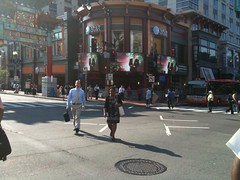 Michael Humphrey writes at Salon.com about how he lost 80 pounds after moving to New York City:
Michael Humphrey writes at Salon.com about how he lost 80 pounds after moving to New York City:Back in the Midwest, where I lived my entire adult life, the most common question was, "How did you do it?" Some people asked with a wink and nod -- you know those vain coastal people and their shortcuts. No, I didn't have surgery, didn't take supplements, didn't hire a trainer or even buy a miracle-cure book.It's not just living in the city - it's about living in a city designed to facilitate walking & biking:
I walked more, and I ate less.
Part of my diet plan was simple necessity. Back home, I drove a car everywhere I went. I cherry-picked parking spots to get as close to the door as possible, shaving my walk to the minimum. But my normal daily walk in New York City was about three miles, just getting to school, walking to work either in Greenwich Village or Midtown and meeting my friends and wife for dinner.
Cities and states with more sidewalks and bike paths tend to have slimmer residents than locations where people must rely on non-active, car transportation, a new study finds.
Those cities with the highest levels of active commuting and lower obesity rates tended to be the older U.S. cities with well-developed public transit systems in the Northeast (Boston, New York and Washington, D.C.) and on the West Coast (Seattle and San Francisco). More than 10 percent of work trips in these cities involved walking or biking, said study researcher David Bassett, of the Obesity Research Center, University of Tennessee, Knoxville.
Posted by
TheGreenMiles
at
Tuesday, July 05, 2011
Sunday, July 3, 2011
Vote Today to Support Virginia Conservation Network
The Virginia Conservation Network is in the running to win a free Toyota Prius. Voting is today only (Sunday, July 3rd), so please take a moment to vote right now!
Posted by
TheGreenMiles
at
Sunday, July 03, 2011
Friday, July 1, 2011
Packed House for KeepTheBan.org Uranium Mining Event in Arlington
 I went to an information session on uranium mining last night at the Arlington Central Library hosted by KeepTheBan.org. You can read up on the many reasons the 30-year ongoing uranium mining ban Virginia has been such an important protection for Virginians on their website. But here were the key takeaways for me:
I went to an information session on uranium mining last night at the Arlington Central Library hosted by KeepTheBan.org. You can read up on the many reasons the 30-year ongoing uranium mining ban Virginia has been such an important protection for Virginians on their website. But here were the key takeaways for me:- The biggest risk from uranium mining is that a catastrophic flood would wash radioactive mine waste downstream. The proposed Coles Hill mine site is in a FEMA-designated flood zone and upstream from four drinking water intakes. How this is even a question for anyone in Richmond, I do not understand.
- The Coles Hill Site alone would generate at least 28 million tons of waste. Exposure to uranium waste has been linked to increases in leukemia, kidney disease and other severe health problems.
- If mining does take place, it would have no impact on Virginia electricity rates. The uranium "yellow cake" won't even be processed into nuclear fuel rods here in Virginia - it'll be shipped out of state, then sold on the international uranium market. (Much like offshore drilling would have no impact on gas prices in Virginia or anywhere else.)
- Think this isn't an issue where you live? The Virginia General Assembly & Gov. Bob McDonnell can't just repeal the ban for one site - they'd have to lift it for the entire state. There are also uranium deposits in the Occoquan River and Rappahannock River watersheds. If the ban is lifted, communities all over the state could be at risk.
- Uranium investors claim the site will host 350 to 400 jobs, but KeepTheBan.org reports they looked the 9 active uranium mine sites they found in the US and saw only about 400 jobs total. "I'm all for jobs, so why are we talking about uranium mining that could scare off other employers? Why aren't we talking about trying to lure something like an auto manufacturing plant would create not just a few hundred jobs but thousands of jobs?" asked Nathan Lott, executive director of the Virginia Conservation Network.
- The price of uranium has wildly fluctuated in recent years. If the price plummets, the site could shut down, leaving none of the jobs and plenty of radioactive waste.
- An audience member reported Virginia Uranium is telling people it's not true that there are no active uranium mines east of the Mississippi River, that small amounts of uranium are found in conjunction with phosphorous mining in Alabama & Florida. "If Alabama is so representative of uranium mining, why aren't they flying legislators there instead of France?" asked Nathan Lott, executive director of the Virginia Conservation Network.
I know how important knocking on doors is, so it's hard to fault people like Adam Ebbin, Barbara Favola, Rob Krupicka & Caren Merrick for not attending, but ... what about Del. Jim Scott and State Sen. Dick Saslaw, who are in safe districts? Was disappointing to see them miss the only KeepTheBan.org workshop in Northern Virginia this summer. (There will also be workshops in Roanoke on July 19 and in Harrisonburg on July 21.)
If you want to keep Virginia's uranium mining ban in place, you need to take action now. Sign the petition at KeepTheBan.org and "like" them on Facebook to get more updates.
Both Del. Englin & Del. Plum visited a former uranium mine in France organized by Virginia Uranium. Del. Englin's trip to France was paid in full by Virginia Uranium, while Del. Plum paid his own way.
Here's Del. Englin's take on the trip:
And here's Del. Plum:
When I returned home after the meeting, I found this postcard in my mailbox from Del. Englin:
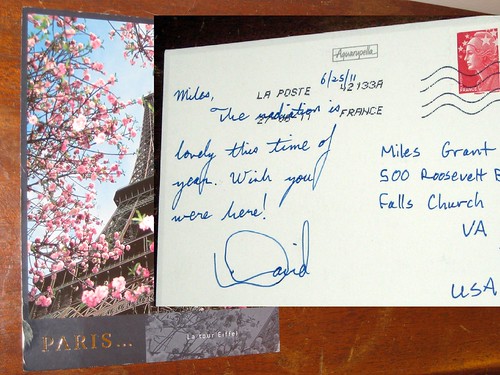
Posted by
TheGreenMiles
at
Friday, July 01, 2011
Subscribe to:
Comments (Atom)








